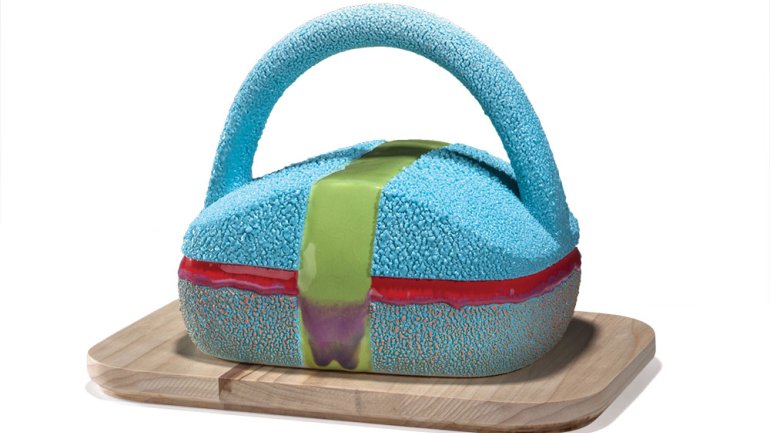Fired Up
Fired Up
John Souter’s ceramics can, at first glance, look like elaborate confections. Rendered in vivid colors and unexpected forms, his sculptural porcelain works command attention and enchanted curiosity, like rows of sweet treats in a bakery window.
His hallmark technique of multiple firings – sometimes up to 20 times – is the icing on the cake. It results in a reticulated glaze, lending a unique textural element that begs for a closer look. Some might see beads of dew, or sweat; others will think of sponges or nonpareils, even a patch of snow that’s been doused in freezing rain.
For Souter, 24, leaving each piece open for interpretation is the whole point.
“I want them to be ambiguous,” he says, “because anything ambiguous is going to invoke contemplation; it’s going to remind us of things.” The titles of his works (Cadillac, for example, or The Yin) hint at his thought process, but ultimately, it’s up to each person to decide what the work means: “I want the viewer to see what they want to see.”
Souter didn’t set out to be an artist, but his brief foray into the corporate world – he worked part-time at a Philadelphia life insurance company for a year in college – left him uninspired. He recalled that he had enjoyed throwing on the wheel during a brief pottery unit in high school art class, and got a job at a ceramic supply company, where he also rented a small studio space. “One thing led to another,” he says, and he wound up transferring to the University of the Arts.
In art school, Souter was intrigued by color theory and architecture – Johannes Itten’s The Art of Color and Chartres Cathedral were among his many influences – and the ways color and form interact. “I became interested in these color relationships, and seeing those colors as an object – pulling this color out and making it a tangible thing, shaping it and forming it.”
As he built a foundation in ceramics, throwing pots and mastering the basics, he learned about the concept of multiple firings and became intrigued by its possibilities. “I was just tired of looking at brown pots, brown everything,” he says.
As he began experimenting with handbuilding, “I was making a lot of mistakes. Most people, they get upset and they throw their work away. But that’s the most exciting part to me. It’s not ruined; it’s a step in the process, it’s unexpected.”
To this day, Souter doesn’t have a predictable process. Nor does he have an idea of what, exactly, he wants each piece to look like when he starts out, he says. Sometimes he sketches, sometimes he doesn’t. Sometimes he has colors in mind, other times not. The journey itself is important – leaving room for unexpected twists and turns.
Since graduating from the University of the Arts in 2012, Souter has been busy: the work exchange program at Philadelphia’s Clay Studio, residencies at the Guldagergaard International Ceramic Research Center in Denmark and at Anderson Ranch Arts Center in Colorado, and a solo show – his first – at Snyderman-Works, which represents him. “John was an instant ‘aha!’ moment that Ruth and I both had when we first saw his work,” says Rick Snyderman. (Ruth Snyderman, his wife, is co-owner, and founded Works Gallery in 1965.) “None of his pieces have a certain look, but what they do have is a signature, which is different. That distinctiveness is very important, because it’s what distinguishes a competent artist from a potentially great artist.
“He’s the best unknown artist you’ve never heard of,” Snyderman says. “But that won’t be for very long.”
Danielle Maestretti is a frequent contributor to American Craft.




